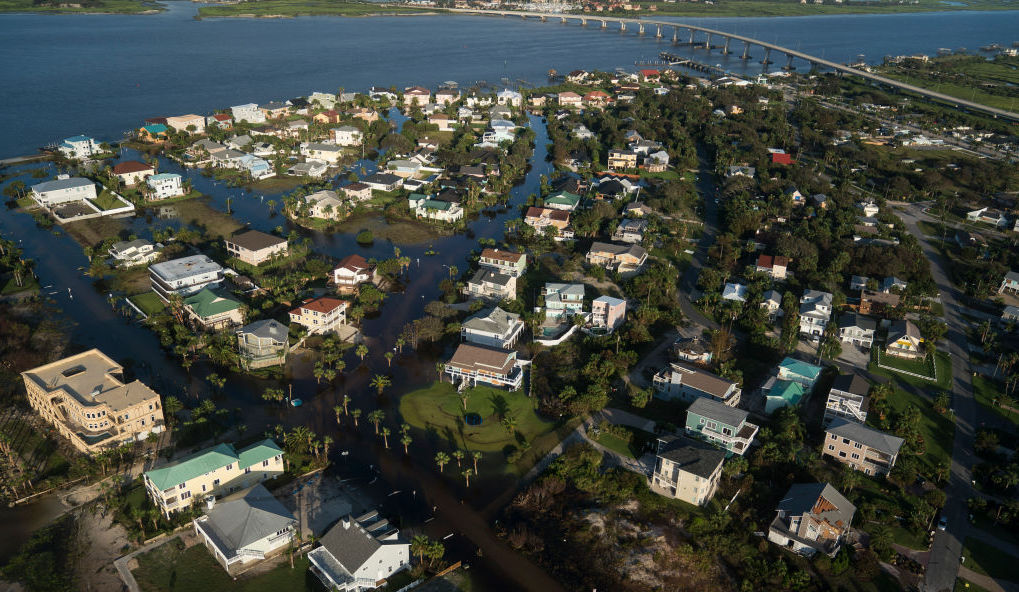Miami is one of the most climate-vulnerable cities in the United States. Plagued by sea level rise and spiraling housing costs, the area is facing a growing “climate gentrification” issue — one that the city is now trying to address with a policy proposal advocates say marks a new stage in Miami’s environmental justice efforts.
In what is being called the first of its kind, Mayor Francis Suarez quietly signed a resolution last month to address climate gentrification in Miami. The move represents a local effort to proactively tackle the impacts of climate change, even as President Donald Trump rolls back Obama-era mechanisms meant to help local governments adapt to mitigate such crises.
Climate gentrification has been used to describe the phenomenon of wealthy residents relocating from once desirable locations along the coast, which are now vulnerable to climate impacts like sea-level rise, and moving to more secure locations. This in turn pushes out pre-existing communities, often lower-income people of color, many of whom are immigrants.
“Developers hold most of the power in this city,” explained Jessica Bolson, an affiliate member with the Florida Climate Institute. Bolson spoke with ThinkProgress about the implications of Miami’s climate gentrification resolution, which she said could mark a turning point in a city where the most marginalized residents have often been left behind.
The resolution, which has mostly flown under the radar and was first widely shared by E&E News, directs the city manager to designate city staff to research the issue of climate gentrification in the city, or the phenomenon of any gentrifying areas further away from the coastline located at higher elevation.
The focus of designated staff will be on “areas that exhibit low area mean income rates and high topographic elevations,” with the intent of helping Miami to take measures to ensure that pre-existing populations can remain in the city even as rising seas push residents further inland.
Perhaps most notably, the resolution will study “the impacts of climate change” on housing prices and investigate how they reinforce “patterns of ‘urban development that lead to displacement (and sometimes entrenchment) of existing populations'” — or, gentrification as it is understood more broadly.
Miami’s resolution draws heavily on an April 2018 Harvard University study by Jesse Keenan, Thomas Hill, and Anurag Gumber. That study singled out Miami-Dade County and tracked property values between 1971 and 2017 based on their elevation and vulnerability to sea-level rise — an issue that is disproportionately hurting low-income communities and people of color.
While the study acknowledged that climate gentrification is still evolving as a concept, the authors found ample evidence in Miami-Dade of properties at higher elevations rising in value across more than three-quarters of the over 800,000 property sales examined. And all but one of the 25 jurisdictions studied saw prices increase.
The cost of living also rose, forcing pre-existing populations to relocate and freeing up the areas for more affluent counterparts.
Rather than a law mandating immediate action targeting such trends, Miami’s resolution instead lays the foundation for further research. And while the process is in its preliminary stages, local organizers said that higher elevation areas with rapidly shifting demographics will likely be given more attention, including Little Haiti, located several neighborhoods away from Miami’s downtown area.
Climate gentrification is nothing new for Little Haiti. As ThinkProgress reported in August, the neighborhood — known for its thriving diaspora culture and hard-won way of life — has been suffering under the weight of soaring housing costs. Unable to afford rent and bowing to pressure from perspective buyers, many residents are being forced to leave. They are being replaced by whiter, wealthier occupants seeking to move away from Miami’s receding shoreline and towards higher ground.
Locals have been vocal in their fight against the displacement, bringing it to the attention of city officials. And for those who work actively on climate issues in Florida, the move can’t come soon enough.
“For me it signals that the county and the city are really taking these issues more seriously,” said Bolson. She explained that climate change conversations are a fact of life in imperiled cities like Miami, but that the city has been historically “behind the curve” when it comes to environmental justice.
“The wealthy people will probably be fine, but the marginalized people, the poor people in Miami… are not included in climate change discussions,” she said. “It’s really concerning. What will happen to these communities in the future? They’re vulnerable right now, they’ll only be more vulnerable.”
Bolson said that Miami’s climate change resolution is an indicator that the city has begun to acknowledge the outsized power property developers hold, especially over marginalized communities. That’s a sentiment shared by local organizations working to fight climate change and its impacts.
“We have a housing crisis in [Miami-Dade] county, these people are being slowly pushed out of their own communities where they’ve lived for so many years,” Yoca Arditi-Rocha, co-executive director for the CLEO Institute, told ThinkProgress.
And while the effort is currently limited to the Miami area, Arditi-Rocha hopes that the resolution is a sign of bigger things to come in Florida, a state threatened not only by sea-level rise but also by increasingly devastating hurricanes and heat waves.
“Unfortunately, Miami has been dubbed ground-zero for sea-level rise,” she said. “I hope that the mayor and also our county take on the responsibility to lead… [and] show the way for other municipalities in our state.”
While Miami is taking steps to confront the byproducts of climate change, other cities have been hindered by rollbacks on the federal level.
In 2017, President Donald Trump disbanded a federal advisory panel for the National Climate Assessment, one meant to aid local policymakers and private sector officials in incorporating federal climate analysis into their long-term planning. That move left city and state governments without a useful resource to help them translate national climate findings into local policy.
The panel has since been revived to an extent, albeit not by the federal government. Columbia University’s Earth Institute Research Program on Sustainability Policy and Management is working in partnership with the state of New York to deliver the report the dissolved panel intended to write. That report is expected at some point next year, but in the interim, cities across the country from New York to New Orleans are grappling with very immediate climate realities, like sea-level rise.
Miami’s climate gentrification resolution, however, is an indicator that some cities may seek to act swiftly on their own, with or without direction at a national level. Through the resolution, Miami may also provide an example for others. But the city is still scrambling to get a hold on a spiraling problem, one that residents priced out of their higher-elevation homes say is already severely impacting them.
Not helping matters is the lack of press surrounding the resolution, which has failed to gain much attention via word-of-mouth. The move has largely flown under the radar, with even some of the city’s climate activists surprised to learn about it when contacted by ThinkProgress. That could pose a challenge to any hopes of encouraging other cities to pursue similar endeavors.
But Bolson, who is affiliated with the Florida Climate Institute, sounded an optimistic note; with Miami already facing the impacts of climate change, Bolson said, the vulnerable city has an opportunity to serve as a model.
“Hopefully, [since] we’ll be the first ones to actually deal with these problems,” she said, “we’ll lead the way for how to address them.”



